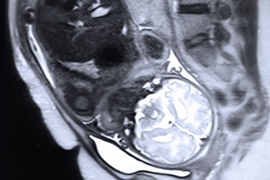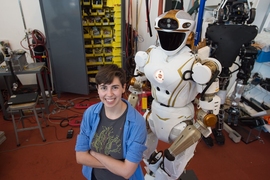Machines that predict the future, robots that patch wounds, and wireless emotion-detectors are just a few of the exciting projects that came out of MIT’s Computer Science and Artificial Intelligence Laboratory (CSAIL) this year. Here’s a sampling of 16 highlights from 2016 that span the many computer science disciplines that make up CSAIL.
Robots for exploring Mars — and your stomach
- A team led by CSAIL director Daniela Rus developed an ingestible origami robot that unfolds in the stomach to patch wounds and remove swallowed batteries.
- Researchers are working on NASA’s humanoid robot, “Valkyrie,” who will be programmed for trips into outer space and to autonomously perform tasks.
- A 3-D printed robot was made of both solids and liquids and printed in one single step, with no assembly required.
Keeping data safe and secure
- CSAIL hosted a cyber summit that convened members of academia, industry, and government, including featured speakers Admiral Michael Rogers, director of the National Security Agency; and Andrew McCabe, deputy director of the Federal Bureau of Investigation.
- Researchers came up with a system for staying anonymous online that uses less bandwidth to transfer large files between anonymous users.
- A deep-learning system called AI2 was shown to be able to predict 85 percent of cyberattacks with the help of some human input.
Advancements in computer vision
- A new imaging technique called Interactive Dynamic Video lets you reach in and “touch” objects in videos using a normal camera.
- Researchers from CSAIL and Israel’s Weizmann Institute of Science produced a movie display called Cinema 3D that uses special lenses and mirrors to allow viewers to watch 3-D movies in a theater without having to wear those clunky 3-D glasses.
- A new deep-learning algorithm can predict human interactions more accurately than ever before, by training itself on footage from TV shows like "Desperate Housewives" and "The Office."
- A group from MIT and Harvard University developed an algorithm that may help astronomers produce the first image of a black hole, stitching together telescope data to essentially turn the planet into one large telescope dish.
Tech to help with health
- A team produced a robot that can help schedule and assign tasks by learning from humans, in fields like medicine and the military.
- Researchers came up with an algorithm for identifying organs in fetal MRI scans to extensively evaluate prenatal health.
- A wireless device called EQ-Radio can tell if you’re excited, happy, angry, or sad, by measuring breathing and heart rhythms.
Algorithms, systems and networks
- A system called “Polaris” was found to load web pages 34 percent faster by decreasing network trips.
- A team analyzed ant-colony behavior to create better algorithms for network communication, for applications such as social networks and collective decision-making among robot swarms.
- Researchers trained neural networks to explain themselves by providing rationales for their decisions.









